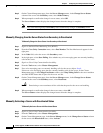
4-12
Install, Upgrade, and Maintenance Guide for Cisco Unity Connection Release 10.x
Chapter 4 Configuring Cisco Unity Connection Cluster
Understanding Cluster in Detail
How a Unity Connection Cluster Works
The Unity Connection cluster feature provides high availability voice messaging through two Unity
Connection servers that are configured in a cluster.
The Unity Connection cluster behavior when both the servers are active:
• The cluster can be assigned a DNS name that is shared by the Unity Connection servers.
• Clients, such as email applications and the web tools available through the Cisco Personal
Communications Assistant (PCA) can connect to either of the Unity Connection server.
• Phone systems can send calls to either of the Unity Connection server.
• Incoming phone traffic load is balanced between the Unity Connection servers by the phone system,
PIMG/TIMG units, or other gateways that are required for the phone system integration.
Each server in a cluster is responsible for handling a share of the incoming calls for the cluster
(answering phone calls and taking messages). The server with Primary status is responsible for the
following functions:
• Homing and publishing the database and message store that are replicated to the other server.
• Sending message notifications and MWI requests (the Connection Notifier service is activated).
• Sending SMTP notifications and VPIM messages (the Connection Message Transfer Agent
service is activated).
• Synchronizing voice messages between Unity Connection and Exchange mailboxes, if the unified
messaging feature is configured (the Unity Connection Mailbox Sync service is activated).
When one of the servers stops functioning (for example, when it is shutdown for maintenance), the
remaining server resumes the responsibility of handling all the incoming calls for the cluster. The
database and message store are replicated to the other server when its functionality is restored.
When the server that stopped functioning is able to resume its normal functions and is activated, it
resumes responsibility of handling its share of incoming calls for the cluster.
To monitor the server status, the Connection Server Role Manager service runs in Cisco Unity
Connection Serviceability on both the servers. This service performs the following functions:
• Starts the applicable services on each server, depending on server status.
• Determines whether critical processes (such as voice message processing, database replication,
voice message synchronization with Exchange, and message store replication) are functioning
normally.
• Initiates changes to server status when the server with Primary status is not functioning or when
critical services are not running.
Note the following limitations when the publisher server is not functioning:
• If the Unity Connection cluster is integrated with an LDAP directory, directory synchronization does
not occur, although authentication continues to work when only the subscriber server is functioning.
When the publisher server is resumes functioning, directory synchronization also resumes.
• If a digital or HTTPS network includes the Unity Connection cluster, directory updates do not occur,
although messages continue to be sent to and from the cluster when only the subscriber server is
functioning. When the publisher server is functioning again, directory updates resume.
The Connection Server Role Manager service sends a keep-alive events between the publisher and
subscriber servers to confirm that the servers are functioning and connected. If one of the servers stops
functioning or the connection between the servers is lost, the Connection Server Role Manager service
waits for the keep-alive events and may require 30 to 60 seconds to detect that the other server is not


















